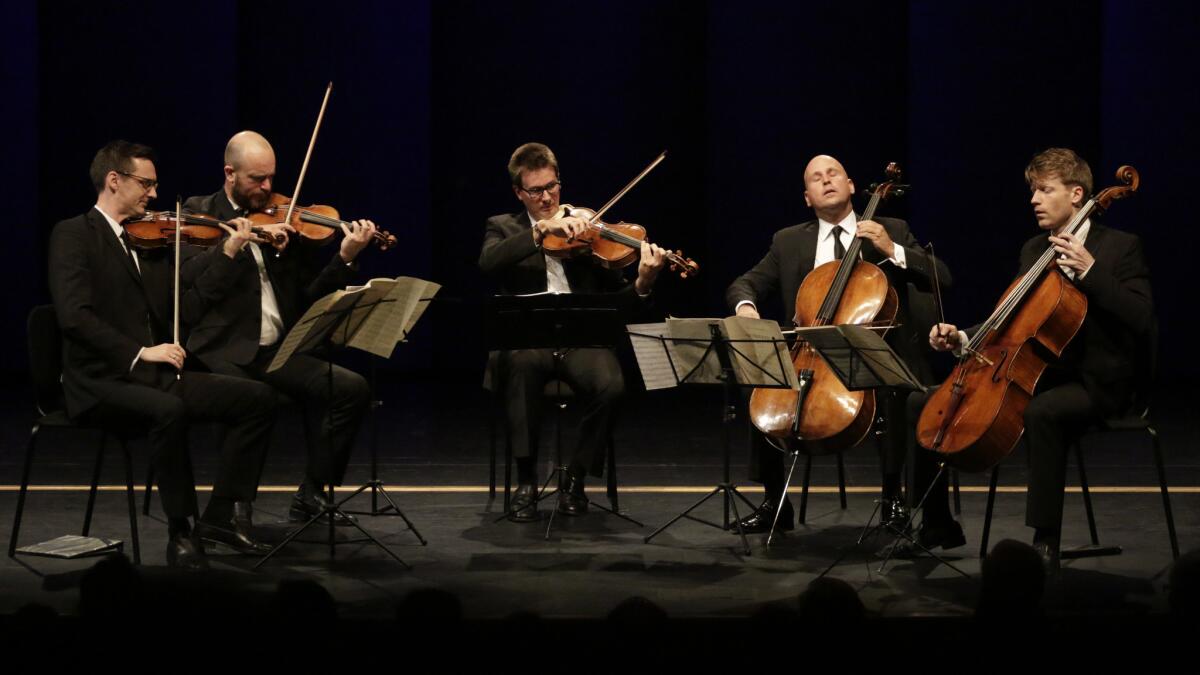Calder Quartet takes a bow with a timeless performance

Robert deMaine, second from right, L.A. Philharmonic’s principal cellist, joins Calder Quartet’s Ben Jacobson, left, Andrew Bulbrook, Jonathan Moerschel and Eric Byers in Schubert’s “String Quintet in C” at the Broad Stage in Santa Monica.
- Share via
Late style is necessarily defined after the fact and thus a category of nostalgia. “Let It Be” is late Beatles but music by young men.
Does the Calder Quartet, which played a superb concert at Santa Monica’s Broad Stage on Thursday night, still qualify as a young American string quartet? It has a young vibe. The players are in their 30s. But the group was formed by Colburn students 17 years ago, and it has already outlasted many a fabulous foursome, whether in classical music or pop.
The program included two great classics. Mozart’s G-major, K. 387, heralded a new maturity in chamber music, but Mozart was only 29 and went on to write much more great chamber music for five years. Schubert’s String Quintet in C is one the most revered pieces in the entire chamber music repertoire. Thomas Mann thought it contained enough transcendence to be suitable for hearing on his deathbed. Schubert was 31 and wrote it two months before he died.
The quintet has a local tradition. Two of the greatest recordings of it were made in Hollywood. The first was by the Hollywood String Quartet in 1951. A decade later violinist Jascha Heifetz and cellist Gregor Piatigorsky led a quintet in a Hollywood studio. Were a Hollywood studio this weekend awaiting the Calders, who were joined Thursday by Los Angeles Philharmonic principal cellist Robert deMaine, we might have a third, and one with the benefit of modern sound.
The adjective that shows up again and again for the C-major Quintet is “sublime.” The added cello is, for Schubert, first a thickening agent, giving the ensemble a luxuriantly rich foundation. In fact, something magically new has entered the room. In the slow movement, the second cellist plays in amorous dialogue with violin, while the other three string instruments purr gently underneath.
The Calders and DeMaine approached the quintet not as late Schubert in communion with the beyond but as a new beginning by a composer with a spring in his step and alive to every sensation around him. It is a long work, nearly an hour, and the players didn’t linger. They didn’t romanticize. Their tone had plenty of body but also grit. The Calders could seem more sober than DeMaine, an enthusiastically expressive cellist, but spirits were high.
A sense of modernity pervaded. The nearly 20-minute first movement was treated as grand theater, the contrasts between all that sublime lyricism and some aggressive thunder were made bold. Thanks to DeMaine’s playful pizzicatos and the Calders’ unflappability, the second movement, in which the lyricism becomes downright angelic, was permitted no Hallmark sentiments. The Finale, played with a hint of Bartók, was the Schubert of tomorrow, the Schubert that was never to be.
Mozart’s G-major Quartet was his first important string quartet, and his youth is evident. He experimented with radical ideas. In the Scherzo, he alternated loud and soft notes in a way that was not heard again for a century. The Calders, who can be rockers when they want to, did not exaggerate. Firm of tone, sure of intonation, round of phrase and rhythmically propulsive, they let Mozart speak for himself.
The concert began with the premiere of Icelandic composer Daníel Bjarnason’s “Stillshot.” In his mid-30s, he was the oldest composer on the program, although in our youth culture he ranks as an emerging composer.
“Stillshot” is a small work, half the length of the first movement of Schubert’s Quintet. It has a great many ideas, given in small surges. Some of these are still — quiet, half-lit overtones. Others are bright bursts, like sudden shots of flavor. There is no sense of development, just interesting incidents. The Calders managed to do something pleasing with every one.
Last month, the ensemble, which has an insufficiently small discography, released a sensational new recording, “The Twenty-Fifth Hour,” of music by Thomas Adès, with the composer joining the Calders in his Piano Quintet. “The Twenty-Fifth Hour” is the title of the beautiful, otherworldly last movement of one of Adès’ “The Four Quarters.”
That extra hour of the day represents in Adès’ music time outside of normal time. Had there been an encore Thursday night, Ades’ movement would have been ideal after Schubert’s quintet, treated here not so much as not something from the beyond but as an hourlong extension of the here and now.
Twitter: @markswed
More to Read
The biggest entertainment stories
Get our big stories about Hollywood, film, television, music, arts, culture and more right in your inbox as soon as they publish.
You may occasionally receive promotional content from the Los Angeles Times.











